The Economics and Statistics Division maintains archives of previous publications for accountability purposes, but makes no updates to keep these documents current with the latest data revisions from Statistics Canada. As a result, information in older documents may not be accurate. Please exercise caution when referring to older documents. For the latest information and historical data, please contact the individual listed to the right.
<--- Return to Archive
For additional information relating to this article, please contact:
October 25, 2021BUSINESS OPENING AND CLOSING, JULY 2021 BUSINESS OPENING AND CLOSING, JULY 2021
Statistics Canada released updated data on monthly business openings and closures for July 2021.
A business will be classified as open if it had no employment in the previous month and then has employment in the next month and a business will be closed if it had employment in the previous month and no employment in the current month. For opening and closing, the reason could be a permanent change (i.e. business exit) or temporary for reasons such as seasonal operations, capital maintenance, restructuring or the COVID-19 situation. Continuing business are those that had employment in both the current and previous month. Active businesses are the sum of continuing and opening business in the current month.
New restrictions were imposed in Nova Scotia at the end of April to contain an outbreak of COVID-19, leading to a substantial reduction in the number of active businesses. These were the largest reductions in the number of active businesses since the first wave of the pandemic in the spring of 2020. As restrictions eased in June and July, the number of active businesses started to increase again in Nova Scotia.
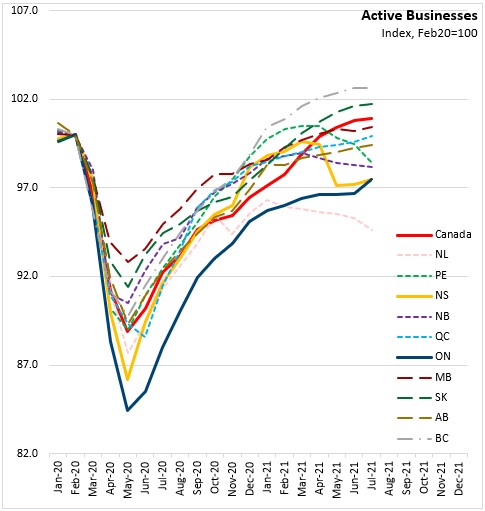
The number of active businesses in Nova Scotia increased 0.3% from June to July 2021. Nationally, active businesses increased 0.1%, largely on a gain in Ontario. The number of active businesses decreased the most in Prince Edward Island. Increases in the number of active businesses were reported in 6 of 10 provinces.
The monthly increase in Nova Scotia's active businesses was concentrated among accommodation and food services as well as construction, which were partially offset by declining businesses in personal/repair services and wholesale trade.
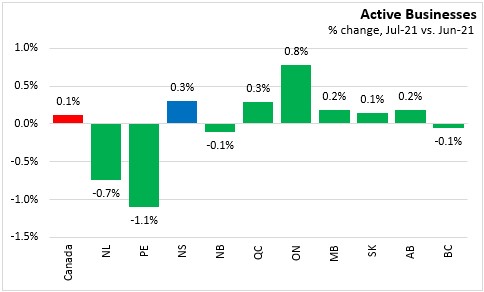
Compared with February 2020, the number of active businesses was down 2.5% for Nova Scotia in July 2021. Nationally, active businesses were up by 0.9% from February 2020 to July 2021, with the gains reported in British Columbia, Saskatchewan, and Manitoba. The number of active businesses was down in seven provinces compared to February 2020 with the largest declines in Newfoundland and Labrador, followed by Nova Scotia and Ontario.
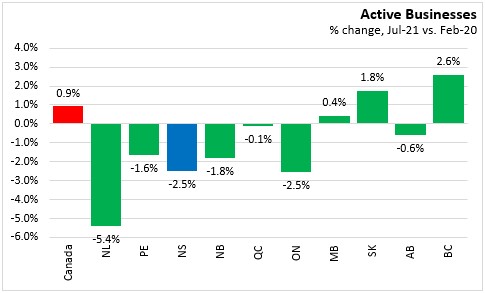
The number of active businesses in Halifax was up 3.0% from February 2020 to July 2021. Among cities (Census Metropolitan Areas), the declines in active businesses from February 2020 to July 2021 were most severe in St. John's and Thunder Bay. The cities with the largest rises in the number of active businesses were Kelowna, Abbotsford-Mission, Vancouver, and Regina.
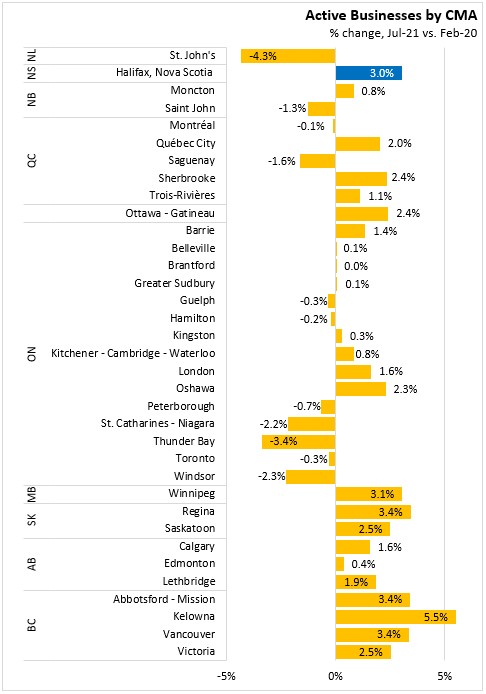
The calculation for the opening, continuing and closure rate have been made based on the number of active business in the previous month. The rate at which business either opened, continued or closed can be examined to see how number of active business has changed.
Most businesses continue operating each month. At the height of COVID-19 related restrictions, the share of businesses that continued to operate from one month to the next fell to 88.7% in Nova Scotia, down from 95.5.% in February 2020. National continuing rates fell from 96.5% in February to 89.2% in April 2020. Business continuing rates rose sharply across all provinces through the summer of 2020.
In July 2021, Nova Scotia's business continuing rate increased to 96.9% while the national rate increased to 94.2% (mostly on an increase in business continuation rates in Ontario).

Nova Scotia’s business opening rate was 3.9% in February 2020 and declined in the month of April 2020. Business opening rates increased sharply in summer of 2020 and remained elevated in the second half of 2020.
Nova Scotia's business opening rate fell again to 3.9% in May 2021 with the imposition of new restrictions. The opening rate remained stable at 4.4% in July 2021.
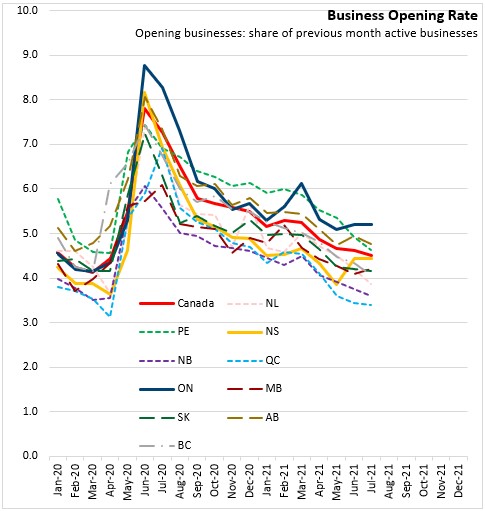
The rate of business closures in Nova Scotia was 3.8% in February 2020. Business closing rate increased sharply during the first two months of the pandemic in 2020 but fell in the summer of 2020.
Nova Scotia's business closing rate increased to 4.7% in June 2021 and declined to 4.6% in July 2021.
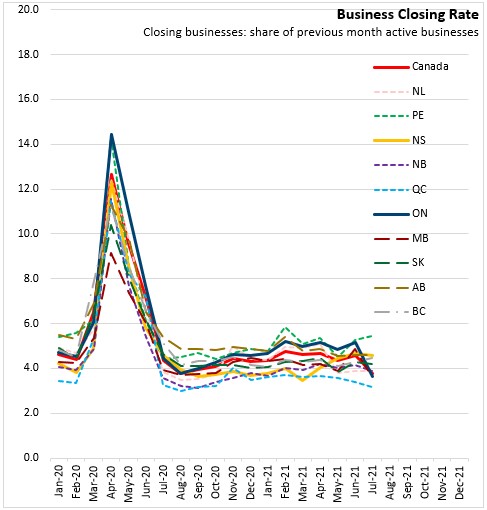
The COVID-19 situation has impacted business sector industries to different degrees. The number of active business in Nova Scotia remained lower in many industries for July 2021 when compared to February 2020. Nova Scotia's largest declines in percentage terms were observed in mining/oil/gas (-13.3%), though this represents only a small number of businesses. The number of active businesses is notably lower than the pre-pandemic threshold for arts/entertainment/recreation (-6.5%), wholesale trade (-3.3%) and accomodation/food (-3.1%).
Nationally, the number of active businesses was up for most industries, with a notably increase in professional/technical and information and culture. The largest declines were reported in arts/entertainment/recreation, accommodation/food, and personal/repair services.
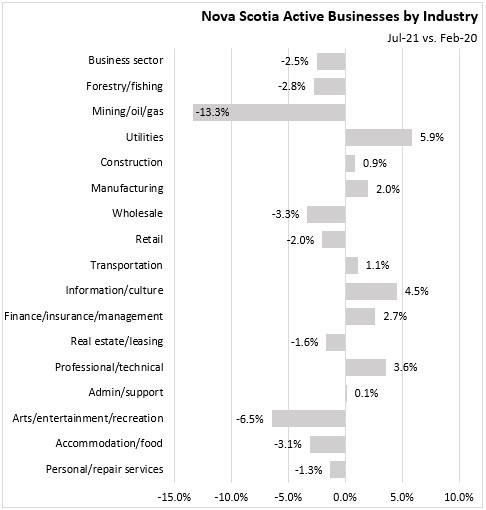
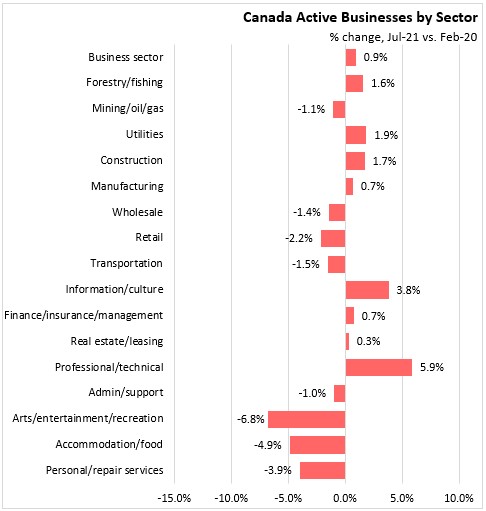
Statistics Canada has broken out specific data for tourism-related industries. This shows that the number of active tourism-related businesses was down 3.0% in Nova Scotia from February 2020 to July 2021. Accommodation, transportation, and travel services reported the largest declines among Nova Scotia tourism businesses. Nationally the decline was 5.8%. Nova Scotia's declines in active tourism businesses have been smaller than the national average for all tourism related industries except accommodations.
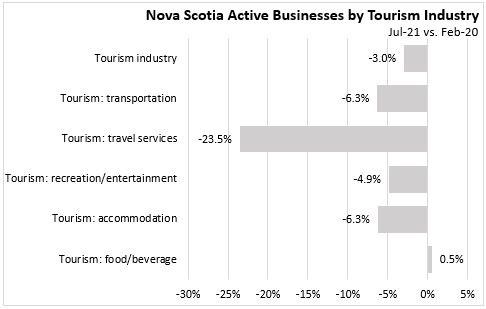

Construction, accommodation and food services and personal/repair services reported the largest changes in the number of businesses from June 2021 to July 2021.

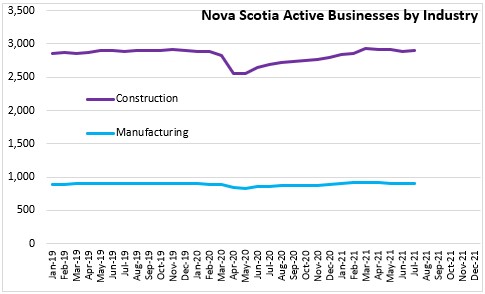
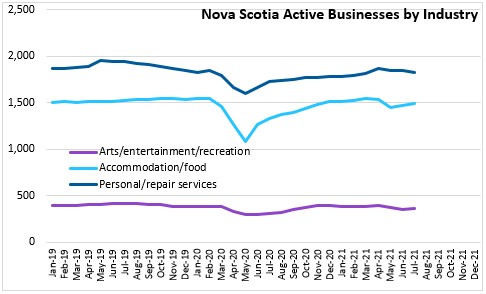
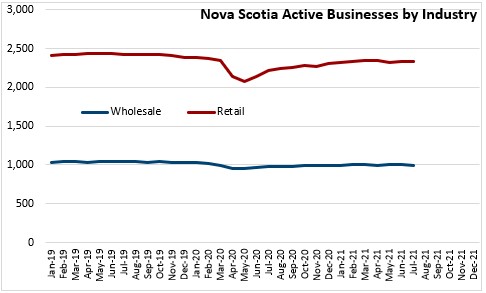

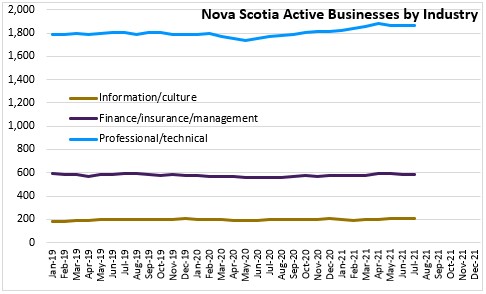
The source data is seasonally adjusted. The data may not aggregate due to firms being classified into multiple industry or geography.
Source: Statistics Canada. Table 33-10-0270-01 Experimental estimates for business openings and closures for Canada, provinces and territories, census metropolitan areas; Methodology: Business Opening and Closing
<--- Return to Archive